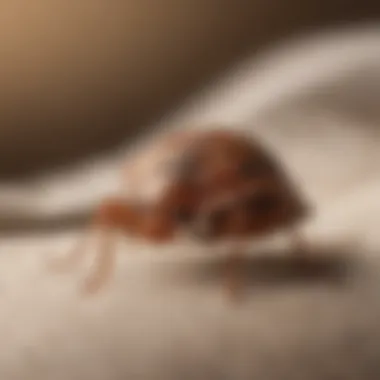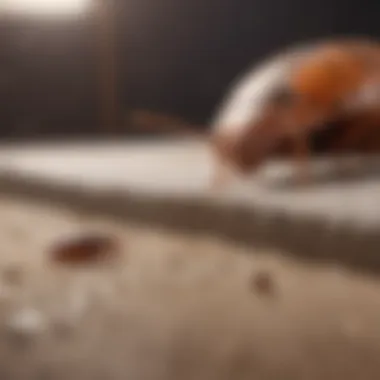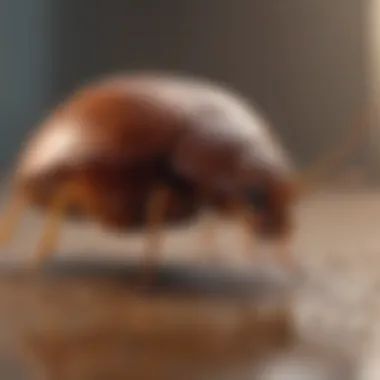Effective Strategies for Eliminating Bed Bugs Infestations


Intro
Bed bugs, scientifically known as Cimex lectularius, have become a significant issue in residential and commercial spaces worldwide. Their resurgence in urban areas especially highlights the pressing need for effective eradication strategies. The small, nocturnal pests are notorious for their ability to hide in various environments and their resilience to many traditional treatment methods. This article delves into the methods that can be employed to eliminate bed bugs, from chemical to non-chemical strategies, while providing insights to maintain a bed bug-free space.
Fascinating Facts About the Animal
Unique Characteristics
Bed bugs are small, oval, and reddish-brown, typically measuring about 4 to 5 millimeters in length. Their flat body shape allows them to hide in small crevices, making it difficult to detect them until an infestation is well underway. Notably, bed bugs do not possess wings. Instead, they rely on human and animal hosts for their sustenance, feeding primarily at night.
Extraordinary Abilities
One fascinating fact is that bed bugs can survive for several months without a meal. Their ability to go into a prolonged state of dormancy allows them to withstand adverse conditions, which poses a unique challenge for eradication efforts. Furthermore, bed bugs can reproduce quickly; a single female can lay hundreds of eggs in her lifetime, contributing to rapid population growth.
Behavior and Habitat
Natural Habitats
Bed bugs thrive in environments close to their food sources. They commonly inhabit areas such as mattress seams, bed frames, and even the cushions of furniture. Their preference for warmth and carbon dioxide emissions from humans makes bedrooms the prime location for infestations. They can also be found in luggage, clothing, and even the seams of carpets, leading to increased spread.
Social Structures
These insects exhibit a somewhat solitary life when it comes to feeding. However, during daylight hours, they prefer to cluster in hiding spots. While they do not have a social structure like ants or bees, their behavior when detecting a host is almost coordinated, leading to a group feed when the opportunity arises.
Recent Scientific Discoveries
Latest Research Findings
Recent studies have revealed that bed bugs have developed resistance to certain pesticides, increasing the difficulty of eradication efforts. Research published in various journals indicates that genetic mutations of bed bugs are linked to treatment failures. Understanding these adaptations is vital for creating effective treatment plans.
Breakthroughs in Animal Biology
Moreover, breakthroughs in genetics have allowed scientists to explore how bed bugs survive in hostile environments. Investigations into their biological mechanisms may pave the way for developing new methods of controlling and eliminating these pests.
Cultural Significance
Animals in Folklore
In folklore, bed bugs often symbolize discomfort or a lack of peace. Many cultures view them as bad omens or as harbingers of misfortune, adding to their negative stigma. These perceptions can influence how individuals respond to infestations in their homes.
Influence on Art and Literature
While there may not be a significant body of work focused solely on bed bugs, they occasionally appear in literature as symbols of annoyance or hardship. Their impact on human living conditions has sparked various artistic expressions, emphasizing the struggle against these pests.
Important Note: Understanding the biological and cultural facets of bed bugs enhances the approach taken to tackle them effectively. This knowledge informs better strategies for eradication and prevention, leading to lasting solutions in pest control.
The next sections will focus on specific eradicating strategies, preventative measures, and the importance of professional extermination.
Understanding Bed Bugs
Understanding bed bugs is crucial for anyone dealing with an infestation. These pests can cause discomfort and anxiety. Gaining insight into their biology, behavior, and signs of infestation allows homeowners and businesses to act quickly and effectively. An informed approach helps in minimizing health risks and the cost of control measures.
Biology and Behavior of Bed Bugs
Bed bugs, scientifically known as Cimex lectularius, are small, elusive insects that primarily feed on the blood of humans. Their size, usually between 4-5 mm, makes them difficult to see with the naked eye. Bed bugs are nocturnal, meaning they are most active at night. This behavior complicates detection, as they often hide in crevices during the day, including beds, furniture, and walls.
They reproduce quickly; a single female can lay hundreds of eggs in her lifetime. The life cycle of a bed bug consists of five stages, each requiring a blood meal to molt into the next stage. This underscores the importance of timely intervention. Left unchecked, an infestation can grow exponentially within a few months.


Bed bugs are resistant to many common pesticides. Their flattened bodies allow them to hide in narrow spaces, complicating treatment efforts. Understanding these aspects is essential for developing effective control strategies.
Signs of Bed Bug Infestation
Identifying the signs of a bed bug infestation is critical for prompt action. Some key indications include:
- Bite Marks: Users frequently find red, itchy welts on their skin after sleeping, which is the result of bed bug bites.
- Fecal Stains: Small, dark spots on bedding or furniture are signs of bed bug feces. These stains may appear as tiny dots, similar to ink spots.
- Eggs and Shells: Bed bug eggs are tiny and sticky, while molted shells indicate their presence.
- Unpleasant Odor: A musty smell in infested areas may come from the bugs' scent glands.
Being alert to these signs can help individuals determine if they need to take action against bed bugs. Immediate response is recommended to avoid further complications and a more extensive infestation.
"Early detection and thoughtful action are key to successfully combating bed bug infestations."
Assessing the Severity of Infestation
Assessing the severity of a bed bug infestation is a critical step in the eradication process. Understanding the extent of the problem allows for a more targeted and effective response. It ensures that the treatment methods employed are proportional to the scale of the infestation, potentially saving time and resources. This assessment also aids in determining whether professional help is necessary.
Home Inspection Techniques
To evaluate your home for bed bug activity, a systematic approach is essential. Begin with a thorough examination of common hiding spots, like seams in mattresses and box springs, cracks in walls, and behind baseboards. Use a flashlight to illuminate dark areas. During this inspection, look for live bugs, shed skins, and dark spots that may indicate fecal matter from the bugs.
- Prepare your space by removing blankets, bedding, and any items that may obstruct your view.
- Use a vacuum to collect any potential insects you find. Remember to seal the vacuum bag afterward.
- Check furniture carefully, moving cushions and inspecting under or behind them. Bed bugs are known to hide in various materials, so be thorough.
It can also be helpful to create a checklist during the inspection to document where you have looked and what you have found. This organized approach provides clarity on the extent of the infestation.
Identifying Infested Items
Identifying infested items is vital in managing bed bugs effectively. Bed bugs can easily hitch a ride on personal belongings, including clothing, luggage, and second-hand furniture.
- Examine clothing before bringing it into your home after travel. Look for any signs of bed bugs, especially at seams and folds.
- Inspect luggage after returning from trips. A common place for bugs to hide is in the crevices of your bags.
- Be cautious with second-hand purchases, as these items may harbor bed bugs. Fully inspect any furniture or clothing before introducing them into your home.
When infested items are discovered, it is crucial to isolate and treat them promptly. Washing clothing in hot water and drying them on high heat can be effective at killing bed bugs and their eggs.
An early and thorough assessment can dramatically influence the effectiveness of control measures against bed bugs.
In summary, assessing the severity of an infestation through diligent inspection and identification of infested items allows for targeted interventions. It not only provides clarity on the extent of the problem but also aids in planning appropriate elimination strategies.
Chemical Methods of Bed Bug Control
Chemical methods of bed bug control remain a cornerstone in effectively addressing infestations. While non-chemical approaches exist, the potency and immediate results provided by insecticides often make them a preferred choice. Understanding how to use these chemicals can greatly enhance one’s ability to eliminate these pests. Additionally, the market today offers a range of products with differing active ingredients, making it essential for consumers to choose wisely in order to combat these resilient insects effectively.
Insecticides and Their Efficacy
Insecticides are designed to target the biology of bed bugs. Different types act in various ways. Some examples include pyrethroids, neonicotinoids, and insect growth regulators. Each has its own mode of action. For example, pyrethroids disrupt the nervous system of bed bugs, leading to paralysis and death, while neonicotinoids interfere with their neurotransmitter functions.
Careful selection of insecticides is critical. Not all products are effective against all life stages of bed bugs, which include eggs, nymphs, and adults. This fact means that while some insecticides may work well on adults, they might not affect eggs adequately, allowing future infestations to emerge. Therefore, when selecting an insecticide, it is integral to consider whether it targets all life stages and has a residual effect that lasts for some time after application.
Application Techniques for Maximum Effect
Proper application techniques play a vital role in the effectiveness of chemical control. Here are some common strategies to maximize the impact of insecticides:
- Targeted Application: Spray directly on areas where bed bugs are likely to hide or travel. This includes bed frames, mattresses, baseboards, and even behind electrical outlets.
- Dust Treatments: Use dust formulations in wall voids and other inaccessible areas. Dust penetrates cracks effectively and has residual effectiveness.
- Follow the Instructions: Always adhere to the manufacturer's guidelines for dosage and application frequency. Overuse can lead to resistance and may compromise safety.
It can be beneficial to monitor treated areas for signs of bed bug activity post-application. This monitoring will help determine the effectiveness of the application and inform whether retreatment is necessary.
Safety Precautions with Chemical Treatments
Utilizing chemical treatments for bed bug removal necessitates a focus on safety. Chemicals can pose various risks to humans and pets if not handled properly. Here are some important safety considerations:


- Read Labels Carefully: Product labels contain essential information regarding safety precautions, re-entry intervals, and what to do in case of exposure.
- Protective Gear: Use gloves, masks, and goggles when handling insecticides to minimize exposure risks.
- Ventilation: Ensure that treated areas are well-ventilated before allowing people or pets back into the space.
- Child and Pet Safety: Keep all insecticides out of reach of children and pets. It is advisable to vacate the premises during and after treatment until it is safe to return.
Chemical control can yield fast results but requires strict adherence to safety protocols to ensure not only efficacy but also prevention of adverse effects.
Non-Chemical Approaches to Bed Bug Elimination
Non-chemical methods of eliminating bed bugs are essential components of an effective strategy to tackle infestations. These approaches not only provide alternative solutions for those who prefer to avoid chemical treatments but also complement chemical methods by offering ways to enhance effectiveness. The use of non-chemical techniques can provide immediate results while also minimizing potential health risks associated with insecticides. It is vital to approach these methods with a clear understanding of their practical applications and limitations.
Heat Treatment Methods
Heat treatment is one of the most effective non-chemical approaches to control bed bugs. This method involves heating infested areas to a temperature that is lethal to the bugs, generally above 120°F (49°C). Professional services often employ specialized equipment to deliver consistent heat throughout the affected space.
**Benefits:
- Effectiveness**: Heat treatment can kill all life stages of bed bugs, including eggs.
- Non-toxic**: It eliminates the need for chemicals, making it safer for households with children or pets.
- Quick results**: Typically, the entire process can be completed in one day, allowing residents to return quickly.
The key consideration is ensuring even heat distribution. Poorly heated areas may allow some bugs to survive. Moreover, it is wise to remove items that can be damaged by high temperatures, such as electronics or flammable materials.
Cold Treatment Methods
Cold treatment or freezing is another viable non-chemical option. This method works by exposing bed bugs to subzero temperatures for a sustained period, typically at least four days. It is possible to use a household freezer, provided it can maintain a temperature of -0°F (-18°C) or lower.
**Benefits:
- Accessibility**: Many households already have freezers, making this an economical choice.
- No chemical residues**: Just like heat treatment, cold treatment does not leave behind harmful residues.
However, it is crucial to note that not all items can fit into a freezer. Large furniture or multiple items may need to be treated using portable freezing units provided by some pest control companies.
Diatomaceous Earth and Other Natural Remedies
Diatomaceous earth is a naturally occurring, soft sedimentary rock. When used as an insecticide, it is effective in dealing with bed bugs due to its desiccating properties. The microscopic sharp edges of diatomaceous earth pierce the exoskeletons of bed bugs, causing them to dehydrate and die.
**How to Use:
- Application**: Sprinkle diatomaceous earth in areas where bed bugs are likely to conceal themselves, such as along baseboards or in crevices.
- Safety**: Ensure it is food grade to ensure safety for humans and pets.
Other natural remedies include essential oils and natural insect repellents, although their effectiveness is debated among experts. Some essential oils, like tea tree oil, may repel bed bugs but usually won’t eliminate an infestation on their own. Testing different methods may be necessary to find the best fit.
Non-chemical methods often require persistence and thoroughness. Combining several of these approaches may yield the best results in eliminating bed bugs effectively.
The importance of non-chemical approaches cannot be understated. They provide essential alternatives and complements to chemical treatments, making a comprehensive pest control strategy. By understanding and implementing these methods, one can contribute significantly to establishing a bed bug-free environment.
Preventative Measures Against Bed Bugs
Effective prevention is critical when dealing with bed bugs. Not only do these pests disrupt sleep, but they also create psychological distress. Implementing preventative measures can significantly reduce the risk of infestations, ultimately protecting your home or business from the significant costs and inconvenience that removal typically entails.
Understanding the contributing factors of bed bug infestations is essential. Factors include travel, shared living spaces, and even used furniture. Identifying these risks enables individuals to develop strategies tailored to their specific environments and lifestyles.
Best Practices for Travel and Hotel Stays
Traveling can expose you to bed bugs, especially in hotels and public transportation. Here are some best practices to minimize your risk:
- Inspect Before You Settle: Upon entering a hotel room, inspect the mattress seams, headboard, and luggage racks for any signs of bed bugs.
- Keep Luggage Elevated: Use luggage racks or place bags on hard surfaces rather than on beds or upholstered furniture.
- Avoid Unused Furniture: Do not keep personal items in places like drawers or non-designated space that may harbor these pests.
- Report Issues Immediately: If you find bed bugs, inform hotel management right away. They should take immediate action to resolve the problem.
By following these practices, travelers can significantly decrease the chances of bringing bed bugs home with them.
Maintaining a Bed Bug-Free Home


A consistent routine can help keep your home free from bed bugs. The following steps can aid in prevention:
- Regular Inspections: Check bedrooms, living areas, and common spaces frequently. Look in places where bed bugs often hide, like behind headboards or under furniture.
- Clean and Declutter: Regular vacuuming and cleaning can remove potential hiding spots. Also, decluttering reduces the number of possible locations for bed bugs to reside.
- Use Protective Covers: Bed bug-proof encasements for mattresses and pillows thwart access, limiting infestation chances.
- Seal Cracks and Crevices: Regularly inspect and seal any openings in floors, walls, and furniture to prevent bed bugs from moving in.
- Educate Family Members: Make sure everyone in the household understands how to identify signs of bed bugs. For instance, dark spots on bedding or a sweet, musty odor can indicate a problem.
When to Call Professional Exterminators
Bed bug infestations can escalate quickly and may become overwhelming for homeowners and business proprietors. Knowing when to seek expert help is crucial in managing these pests effectively. Professional exterminators possess specialized knowledge, advanced treatment methods, and can provide long-term solutions that are often beyond the capabilities of average homeowners.
In this section, we will explore the importance of calling for professional help, key indicators that suggest the need for expert intervention, and how to properly evaluate pest control services.
Identifying the Need for Expert Help
Determining whether to call a professional pest control service often depends on various factors. Here are the critical indicators:
- Severity of Infestation: If you notice multiple bed bugs, shed skins, or droppings throughout your home, it may indicate a larger infestation. An infestation that spreads beyond a single room typically requires professional treatment.
- Ineffectiveness of Home Remedies: Often, homeowners try various do-it-yourself methods before calling for help. If you find that these methods are not producing positive results within a reasonable timeframe, it may be time to contact an expert.
- History of Infestations: If you’ve experienced bed bugs previously in your home or building, the likelihood of re-infestation increases. Professionals can implement preventative measures based on past experiences.
- Health Concerns: The bites from bed bugs may lead to allergies or secondary infections due to scratching. If occupants are experiencing adverse health effects, seeking professional assistance is essential.
When these factors come into play, the value of expert help becomes clear. They can not only eliminate the current pest problem but also educate homeowners on maintaining a pest-free environment.
Evaluating Pest Control Services
Choosing the right pest control service is just as critical as deciding to call one. Here are several considerations to keep in mind when evaluating pest control services:
- Experience and Expertise: Look for companies that specialize in bed bug elimination. Ask about their years in the industry, training, and methods of treatment.
- Reputation and Reviews: Research the company’s reputation through online reviews, testimonials, and by checking platforms like Reddit or Facebook for consumer feedback. A positive track record often signifies reliability.
- Certifications and Licensing: Ensure that the pest control service holds the necessary licenses and certifications required in your area. This is a sign of professionalism and adherence to industry standards.
- Treatment Plans: Inquire about their treatment plans. A reputable company will offer a comprehensive approach to pest control, including follow-up care and preventative measures.
- Cost and Contracts: Obtain detailed estimates from several companies. Be wary of very low prices, as they may reflect subpar service. Clarify what is included in the cost and any contracts involved.
By taking these factors into account, you can select a pest control service that meets your needs and ensures the effective elimination of bed bugs. Making an informed decision can lead to a more successful resolution to your bed bug problems.
Legal Considerations in Bed Bug Cases
The issue of bed bug infestations raises significant legal considerations for both tenants and landlords. It is crucial to understand the rights and obligations of each party involved. This understanding can not only help resolve disputes but also prevent future infestations through clear communication and responsibilities. Legal knowledge provides a foundational framework for parties to navigate complex situations involving bed bugs.
Tenant Rights and Responsibilities
Tenants have specific rights when it comes to living in a bed bug-free environment. These rights are often outlined in rental agreements and local laws, typically established to protect public health and property safety.
- Right to Safe Housing: Tenants are entitled to a home free from pests, including bed bugs. This is often considered part of the landlord's obligation to provide habitable housing.
- Reporting Infestations: It is the tenant's responsibility to report any signs of bed bugs to the landlord promptly. Prompt reporting can help mitigate the problem before it spreads, benefitting both parties.
- Rights to Privacy and Treatment: Tenants should be informed about treatment plans and have the right to receive adequate notice before pest control services enter their residence.
In addition, if a tenant fails to report issues in a timely manner, they could potentially be held accountable for exacerbating the infestation. This means it is in both the tenant’s and landlord’s best interests to communicate openly about pest problems.
Landlord Obligations
Landlords also have clear responsibilities in the context of bed bug infestations. Awareness of these obligations can help ensure that they comply with local and state regulations.
- Maintenance of Habitability: Landlords are responsible for maintaining a property that is habitably safe. If an infestation occurs, they must take action to resolve the issue promptly.
- Treatment of Infestations: When a tenant reports bed bugs, the landlord must respond swiftly to arrange for professional pest control treatment. Ignoring reports or delaying action can lead to larger infestations and potential legal consequences.
- Documentation: Keeping detailed records of complaints, treatments, and communications regarding infestations is important. This can protect landlords in case of disputes.
Understanding these legal frameworks is essential in protecting individual rights and maintaining living conditions that are both safe and habitable.
Culmination: Maintaining a Bed Bug-Free Environment
Maintaining a bed bug-free environment is crucial for ensuring both comfort and health in residential and commercial spaces. Bed bugs can create significant distress and negatively impact the quality of life. This conclusion synthesizes effective strategies discussed in the article, emphasizing the importance of vigilance and proactive measures.
Recap of Effective Strategies
In order to successfully eliminate bed bugs, a clear understanding of strategies is necessary. Here are the key points:
- Proper Identification: Recognizing signs of bed bug infestations is the first step. Look for bites on the skin, blood stains on sheets, or small dark spots indicating fecal matter.
- Inspection: Regularly inspect your home, especially areas where people sleep. Check seams of mattresses, cracks in furniture, and baseboards. Detecting problems early makes for easier treatment.
- Chemical and Non-Chemical Treatments: Application of insecticides must be done correctly for effectiveness. Supplementing with non-chemical methods like heat treatments or diatomaceous earth can enhance results. Always prioritize safety and follow product instructions.
- Professional Help: If infestation is severe, contacting professionals who specialize in pest control is advisable. They make informed decisions on effective treatments that may not be accessible to the general public.
By adopting these strategies, individuals can mitigate the risk of infestation and improve the overall environment.
Long-Term Solutions for Prevention
Preventing future bed bug infestations requires consistent efforts over time. Consider the following long-term solutions:
- Educate Yourself and Others: Understanding how bed bugs operate can help in prevention. Share this knowledge with family, friends, and coworkers to create awareness.
- Regular Cleaning: Frequent vacuuming and laundering of bedding can reduce the risk of bringing bed bugs home. Use hot water whenever possible, as it kills both bugs and eggs.
- Travel Smart: When traveling, inspect accommodations for signs of bed bugs. Use protective covers on luggage and clothing.
- Monitor with Traps: Utilizing traps can help in early detection. Place traps near potential entry points but away from direct sunlight or heat sources.







